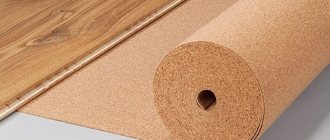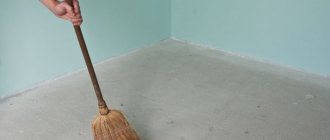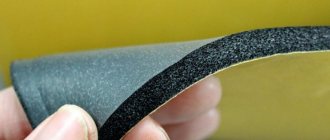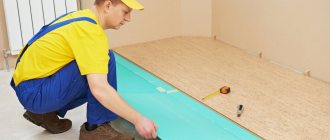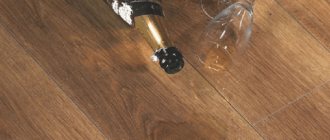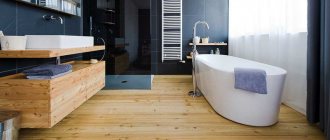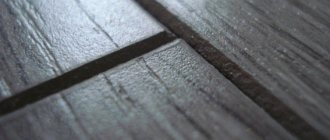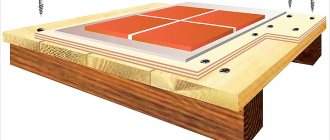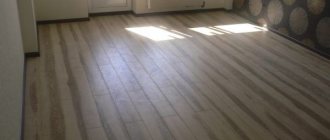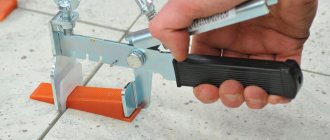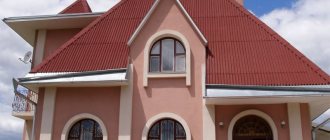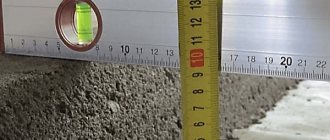It's a great idea to lay the new floor on an underlay made of natural materials, such as cork or pine needles. Cork cloth turns out to be quite expensive, but you can try laying a covering on pressed pine needles. You just need to figure it out, understand the pros and cons of a coniferous substrate for laminate, and the reviews about the material are very good.
Suitable for all floors
Features of coniferous substrate for laminate
The first impression of the material is usually not the best; the backing is somewhat reminiscent of a thin pressed green fiberglass mat. No associations with ecology or natural materials. In fact, the backing material undergoes very serious processing and is intended for use as a lining, auxiliary panel under the laminate. So you shouldn’t expect any positive impressions from him.
The coniferous mat feels very durable and hard
Experts note two quite important characteristics for coniferous substrates:
- Working with the material, especially when laying laminate, is difficult. Cutting and cutting sheets is not easy; even a thin 3 mm coniferous backing for laminate is cut with uneven edges. Therefore, before starting work, you need to stock up on a good cutter, gloves and a means for collecting waste;
- When laying, it is necessary to scrupulously follow the technology of laying the lining from separate sheets. Craftsmen recommend laying out sections, regardless of the orientation of the laminate, only diagonally across the room.
Important! The diagonal arrangement may not be used, for example, if a 4 mm double layer of coniferous substrate is laid under the laminate.
Such recommendations are due to the fact that between the sheets it is necessary to leave an expansion joint 1 mm wide. After laying the laminate, after a couple of months under load, the gap will disappear, but in the meantime there is a risk that the lock on the connection of the lamellas may coincide with the void. In this case, the laminate easily fails, and the diagonal arrangement of the coniferous lining sheets reduces the risk to zero.
Sheets are laid out only diagonally
In addition, developers and manufacturers of the material require that under the laminate, a pine needle substrate be laid on a wooden base, preferably a rough ventilated plank floor; in extreme cases, OSB or plywood will do. In Russia, coniferous sheets have long been laid on concrete treated with acrylic primer. It is believed that less severe frosts than in Finland, Sweden and Estonia, the main exporting countries, make it possible to lay laminate on coniferous wood on concrete.
TOP 3 manufacturers of substrates based on pine needles and wood
| Photo | Name | Rating | Price | |
| #1 | Steico underfloor | ⭐ 98 / 100 | More details | |
| #2 | Leroy Merlin | ⭐ 97 / 100 | More details | |
| #3 | Isoplaat | ⭐ 96 / 100 | More details |
Steico underfloor
This spruce underlay is good where soundproofing of floors is important. Supplied in slab form. Ideal for laying under laminate on wooden floors. Often used in private homes. Steico is a leader in the production and sale of this type of substrate.
Steico underfloor (Poland)
pros
- perfectly dampens the sound of steps when moving along the base;
- has excellent thermal insulation properties;
- able to resist moisture well;
Minuses
- afraid of mold.
coniferous underlay Steico underfloor
Leroy Merlin
It acts as a capacitor for the lamellas due to the fact that it is subjected to special processing during manufacturing. This substrate is cheaper than the previous option, but its performance characteristics are quite good.
Coniferous backing from Leroy Merlin
pros
- ideal ratio of cost and quality;
- good soundproofing qualities;
Minuses
- not detected
coniferous backing Leroy Merlin
Isoplaat
The material is able to retain its shape for as long as possible. Suitable for repairing old floors.
Isoplaat (Estonia)
pros
- does not deform;
- absorbs noise well;
- can act as an insulating material;
- does not allow the laminate to cool quickly.
Minuses
- the cost is above average.
coniferous underlayment Isoplaat
Pros and cons of coniferous underlay for laminate flooring
The choice in favor of a lining made of natural pine needles is not as obvious as it might seem at first glance. The material is quite contradictory and does not always meet customer expectations. The reason is simple - coniferous underlayment is produced in huge quantities and is actively used as a sound insulator, and partly as an effective noise and vibration filter, as well as as a lining under laminate and 5 other types of floor coverings.
Advantages of coniferous fabric
All the positive aspects of pine needle linings are provided by the unusual structure of the lining. In some ways it resembles felt, only the fibers are shorter and thicker. This provides at least four main advantages that the main competitors - cork and foamed PP - do not have:
- High strength and durability. The service life of coniferous fabric under laminate easily reaches 20 years. Contact strength when covered with laminate reaches 15 t/m2;
- Excellent noise and sound insulation, much better than foam materials. Using coniferous mats, they insulate the walls and ceiling, while the noise level is reduced to an acoustic silence of 10-15 dB;
- Environmental Safety. Manufacturers declare that in the manufacture of lining material only pine needle processing products are used, including lignin base and resinous substances;
- The material does not rot or rot. Coniferous substrate, unlike cork and foamed polypropylene - PP, has high fire resistance, but there is no information about the use of special protective impregnations.
For your information! The fact that laminate underlay is flame retardant is confirmed by both certificates and practical experience.
The material is slightly charred, but does not give off a flame. This is explained by the high content of carbon dioxide released when deresined pine needles are heated.
Best placed on old wood floors
Disadvantages of pine needle lining material
From the list of negative qualities of coniferous fabric, two main ones can be cited. The material is poorly processed by cutting, and in addition, due to the high content of polysaccharides, it absorbs moisture well and becomes a medium for the development of fungal and putrefactive microflora.
It is difficult to dry a wet sheet; if the laminate is flooded with water, then it is better to replace the coniferous lining; it may take several weeks to dry the sheet, even in the warm season.
Cheap brands of laminate underlays emit an unpleasant odor for quite a long time after installation, so before starting work, the material is usually ventilated from fungicides in the open air.
Question answer
How to lay a coniferous substrate correctly?
Correct laying of the underlay involves laying it diagonally relative to the direction of the finishing floor covering. With this method, it is impossible for the joints of the laminate joints to touch the seams of the insulating plates.
In 2022, the manufacturer changed the substrate installation scheme. Probably, the craftsmen did not want to lay the insulation diagonally. Laying sheets in a straight line is now allowed. It is also possible to lay two layers of pine needles on top of each other, this time diagonally. I am attaching a photo of the instructions.
Why is it necessary to lay the underlay diagonally relative to the direction of the laminate flooring if it lies closely together?
According to the manufacturer's instructions, a gap of 1-2 mm between sheets is required. Pressed needles are wood that has expansion properties depending on temperature and humidity conditions. If the gap is not maintained, the insulation may become stuck, lifting the floor covering.
By the way, due to the uneven edges of the products used, voids form underneath them. When laying laminate flooring, the structure begins to “fall in” under the weight of a person. This trouble will go away over time through shrinkage, but at first questions will arise regarding the professionalism of the craftsmen, leaving an unpleasant aftertaste in the soul.
How then will the sound insulation of the substrate change if it is necessary to leave a gap between it?
I don't know the answer to this question. Most likely, it will not change much - the sound insulation of the installation is calculated for impact noise.
Is it necessary to lay a vapor barrier film under the substrate?
Manufacturers of laminate and parquet boards always require installation of moisture-proof polyethylene for insurance purposes, otherwise the product will be void of warranty.
The manufacturer of Isoplaat (Isoplaat) Estonia claims: it is permissible to lay a substrate on dry concrete, this is due to its porous structure, capable of dissipating a small amount of moisture.
From personal experience: such a substrate was laid on the interfloor concrete floor while no one was asking. But there was a case: the customer was severely flooded. The needles turned into slurry and fell apart in our hands, and we worked without respiratory protection. We inhaled damp, stale fumes, after which there was a lump in my throat and a runny nose for 3 days.
After removing the garbage to the stairwell, we took a week's break to dry, recommending treating the base with an antifungal compound, since white mold and, in some places, black mold had already appeared. In that case, the laminate flooring was installed a week later, and the woman did not apply again.
As a result, it is up to you to decide whether to lay polyethylene or not, although in the situation described above it would not help.
The production claims that the substrate is highly environmentally friendly, is this true?
The certificates posted on the website confirm the highest emission class M1 and the possibility of use in domestic conditions. However, with repeated installation of the substrate during work, your hands and knees itch. The point is fiber particles visible to the eye, similar to glass wool needles. The exception was during one of the last works with a Steico substrate. There was wood dust on the surface, but no needles were observed. I will try to inform you, dear readers, about new observations below, in the comments.
I’ve also heard reviews about the strong absorption properties of pine needle smells, but I haven’t encountered them.
How else can you raise the level of the laminate to the height of the tiles in the hallway?
There's probably nothing else. I don’t recommend using thin plywood; it warps when fastened. A thick extruded polystyrene backing can be used, but it shrinks significantly. I personally saw how a 5 mm sheet became 2-3 mm thick during operation.
The best option is to fill the floor with self-leveling mixtures or stay with the original option.
I admit it is possible to lay coniferous insulation on double-sided tape for rigidity and install any second insulation with a thickness of 2-3 mm. Let's learn a pie that improves soundproofing properties.
How to fix the coniferous substrate or what kind of tape to fasten it together?
The website of the manufacturer Isoplaat talks about the possible fixation of the substrate to the base using glue, and in a recommended manner. We conclude from the previous question that it will not be possible to lay plastic film.
It makes no sense to attach the lining to each other, since the fluffiness and dusty deposits will not give it the opportunity to stick properly. Only metallized adhesive tape is of little help for fastening all types of substrates; ordinary paper tape sticks better. You will need 1 roll 25 meters long per 10 m2 of flooring.
You can also successfully glue the coniferous backing to double-sided tape. As you understand, the surface for applying tape must be well prepared and free of dust and small debris. In such cases, film cannot be used.
Does the coniferous underlay level the floor well due to its thickness?
Spruce substrate has the strongest coefficient of resistance to deformation up to 20,000 kg/m2. Therefore, it is capable of leveling only sharp changes: a protruding screw head, a small pebble, a protruding metal guide - everything that has a small area; so that later, under the weight of the laminate and furniture, the insulation structure can be pushed through and “fall into place.” Otherwise, the lining with the floor covering will repeat and “remember” the shape of the uneven floor.
People came to me with this problem. The old parquet was removed and nails remained in the concrete screed. Yes, I also thought that I misheard or people were confused. But in the photo sent they are clearly visible. It was difficult to pull out the nails and the heads broke. The woman asked if it was possible to bend them and finish them off? Why not? If they do not have the opportunity to level the floor and lay plywood. It is possible to implement such a cost-effective option. In this case, it is optimal to use coniferous insulation as a substrate.
Why then is the substrate so popular, including in Europe?
First of all, it's just business. There is a product - you need to sell it.
And in Europe, products made from pine needles are to a certain extent popular; their use is intended mainly for wooden floors. There is no need to put film on board bases; it is easier to fix the substrate with glue or using a stapler.
In Russia, this type of product was adapted to our conditions of use (concrete apartment floor), which is why the coniferous substrate raises so many questions and contradictions among buyers and finishing specialists.
Laying coniferous substrate
It’s great that a year ago the installation instructions were changed and it became simpler. If I lay it according to the old pattern, following all the recommendations, diagonally, using glue with gaps between each other, I will simply be left without work. Adding in the cost of the needles themselves, about 150 rubles/m2, and installation costs, it will cost a significant amount of money plus a huge amount of time to lay the entire floor covering.
Like most craftsmen, I lay the spruce backing in a straight line or diagonally. Laying the insulation diagonally, I work only when there is no furniture. The cost of such installation of needles is more expensive.
I cut the sheets with a construction knife, breaking the edge of the material, except for the 3 mm thick backing, which is cut through. This must be done carefully, the litter crumbles a lot. I connect them end to end, retreating from the edge of the wall about 10 mm. This distance is sufficient to allow the material to move when the seasons and humidity in the apartment change, respectively. I lay vapor barrier film at the request of the customer and according to the circumstances.
Customers did not contact us for warranty or post-warranty service.
In conclusion, a small table of the effects of various environments on the source material, Steico substrate - Poland, 3mm. The test was carried out for fire resistance and moisture resistance.
The thickness of the coniferous substrate under the laminate
The size and thickness of the material is selected depending on the quality of the rough base poured under the laminate. The most common is a 5 mm coniferous underlay for laminate; it is laid on plank and primed floors, provided that the seams between the boards are cleaned and sanded to the level of the surface.
Sheets 3-4 mm thick can be laid on a plywood base. For the most unsuccessful concrete screeds with bumps and holes, a level difference of more than 3 mm, a 7 mm coniferous backing is placed under the laminate.
Where is spruce backing used?
Softwood dampers are most often used not only for laminate, but also for other types of flooring:
- Linoleum.
- Carpet.
- Lamels, etc.
The spruce lining does not require leveling to the base. The exception is defects that are too significant and conspicuous. The material has the unique ability to adapt and take the shape that is needed.
At the same time, a slight change in shape does not have a negative impact on the appearance of the product and the characteristics of the boards. It is only important to comply with the following condition - the floor boards should not sag.
How to lay coniferous underlay under laminate
The process of laying the lining layer begins with a simple calculation of the number of sheets. The required volume is brought into the room and spread in several rows so that it is more convenient to take the sheet.
Since the laying is done diagonally, the number of sheets in the rows is different each time; moreover, the edges have to be trimmed and adjusted so that each section lies overlapping the seam, and a gap of 1 mm is maintained between adjacent edges.
Secure the backing to the seams only with tape
The first sheets must be checked to see how tightly the laminate adheres to the lining and whether there are any holes or humps. The laid sheets are fastened with metallized tape; ordinary construction tape cannot withstand the load from the laminate. You can use a hint on how to lay a coniferous underlay under a laminate, from the video:
Laying features
Anyone can cope with the installation work of laying a spruce substrate, since there is nothing complicated in the process. Its installation does not require specific knowledge and skills, as well as special equipment. The only thing that is necessary is to follow the basic rules, which ensure high-quality installation.
Installation must be carried out on a subfloor. You must first thoroughly clean it of debris, dirt and dust, since even minor foreign objects can subsequently spoil the quality of the work. If the floor has uneven surfaces, it is best to cover it with sheets of plywood or pour a new screed. In addition, the floor must be waterproofed.
To lay the substrate, you need to purchase a tape measure, pencil or marker, as well as household scissors. Immediately before installation, it is necessary to bring the substrate into the room and let it rest for several days so that the material can adapt to operating conditions.
The laying of the substrate should be carried out at a right angle to the laminate. For convenience, the sheets should be marked. Only after this can you start slicing them. To ensure that the joints between individual substrate slabs do not coincide with the joints of the lamellas, the first elements that will be laid must be cut at a certain angle - 45 degrees. A compensation gap must be left between the wall and the material. After laying this material, you can begin installing the laminate.
Which is better - cork or pine underlay for laminate flooring?
The material is counterfeited, using polymer fillers and binders. It is easy to make a mistake when purchasing a coniferous underlayment, so it is best to purchase underlayment from well-known brands. For example, Estonian "Isoplaat" or Finnish "LATTIALEIJONA". Of the more affordable materials for laminate, you can use products (Russia) or “Cezar” (Poland).
Accordion lining 3 mm thick
It is more difficult to fake cork, and in terms of operation, a laminate on a cork base seems softer and smoother. From a technological point of view, installing cork is faster and easier; it takes longer to tinker with a coniferous lining. However, branded brands of pine needle substrates turn out to be more durable and “tenacious”, so they are more often used under expensive brands of parquet and laminate.
What it is?
Initially, the coniferous substrate was created to prevent heat loss from the room and improve sound insulation properties. But over time, these slabs began to be actively used in laying laminate flooring, parquet boards and even linoleum. Most often, coniferous substrate can be found in the form of small slabs, but some manufacturers also produce the material in rolls.
There are two types of coniferous substrate:
- normal, it is quite thick compared to classic substrates and has a plate thickness of 3.6-7 mm;
- extra thick, characterized by better heat-insulating and sound-absorbing properties, since the sheet thickness varies from 0.8 to 1.2 cm.
Thinner sheets of softwood backing cannot be made due to the type of material used in their manufacture. Greater pressing will lead to loss of sound-insulating and heat-preserving properties.
One side of the substrate is semi-matte, and the connecting side is rough. Coniferous underlayment is produced from coniferous trees. Sawdust and spruce bark are most often used in production, but pine can also be used.
First, all components are thoroughly crushed, passed through steam to eliminate insect and fungal larvae, and then pressed into dense sheets. The last stage of processing the coniferous substrate is treating it with steam under high pressure.
The coniferous substrate made of pine is inferior in its properties to spruce. Therefore, if you have a sufficient budget, it is better to buy material from spruce components.
It is also worth knowing that sometimes the coniferous substrate is called wood fiber. They are the same type of material under different names.
What should you consider when choosing a substrate?
Since the last characteristic is of paramount importance, this problem must be thoroughly understood.
When creating the required thickness of the substrate, you need to calculate what maximum load the floor will experience. In addition, it is worth taking into account those local loads that have less force, but can cause a much more destructive effect. Not so long ago, there was an opinion that the thickness of the substrate should be created in proportion to the load that will be exerted on it. Therefore, the layers tried to make the substrate as thick as possible, but if this was not possible, then they made it thin, from just a few layers.
But it is not always possible to avoid floor defects when laying laminate flooring. Previously, experts tried to smooth out the unevenness of the coating with the help of a thick substrate, but this did not always pay off, due to the fact that an excessively thick layer of the substrate can bend so much that it will cause cracking of the laminate.
Leveling the floor using a thick underlay is not the best solution: the laminate can quickly crack because of this
Therefore, they began to choose the thickness of the underlay for each floor individually.
Important! It is not surprising that when problems arose with choosing a base layer that could combine all these properties, specialists began to use a coniferous base.
